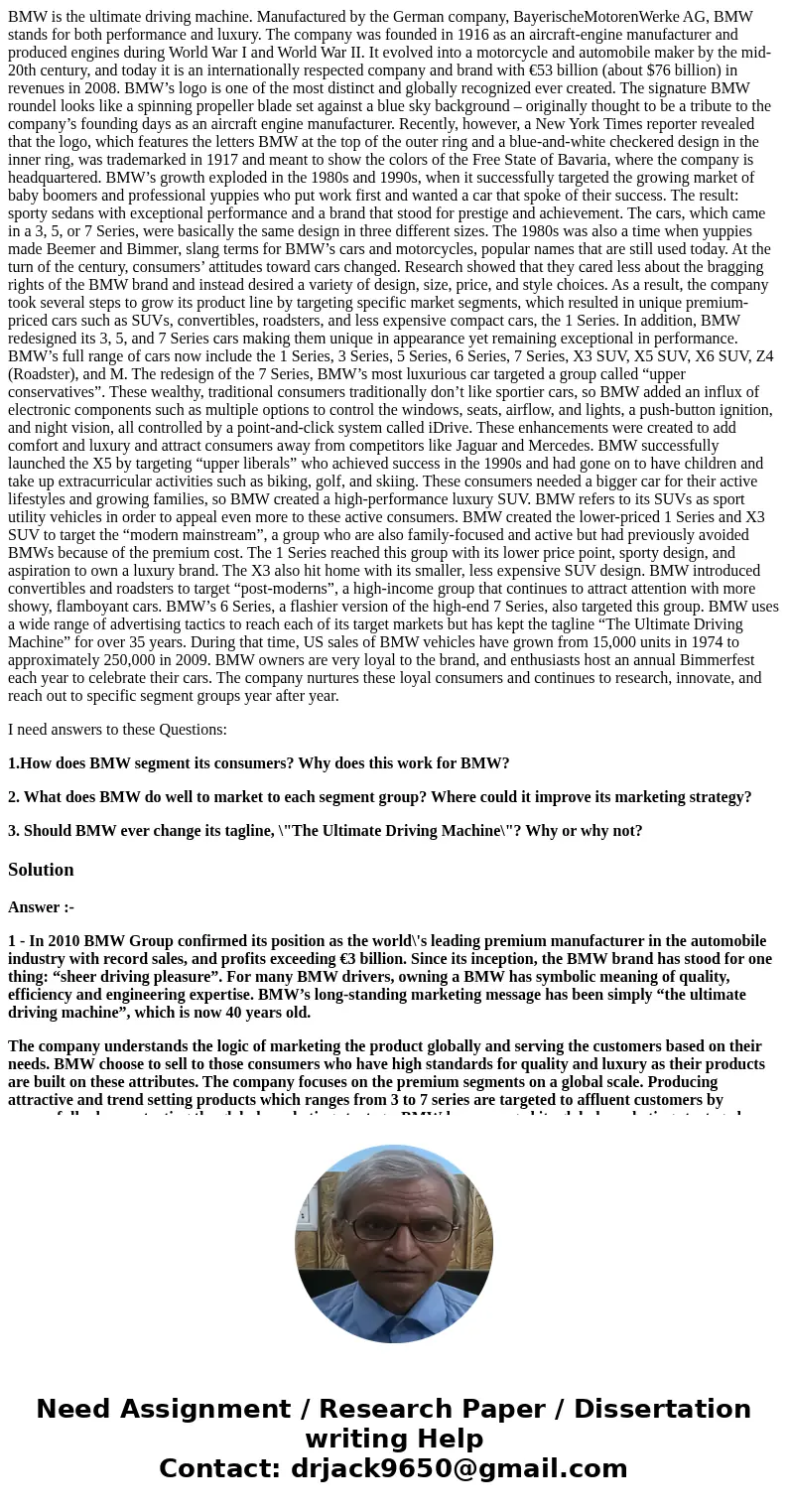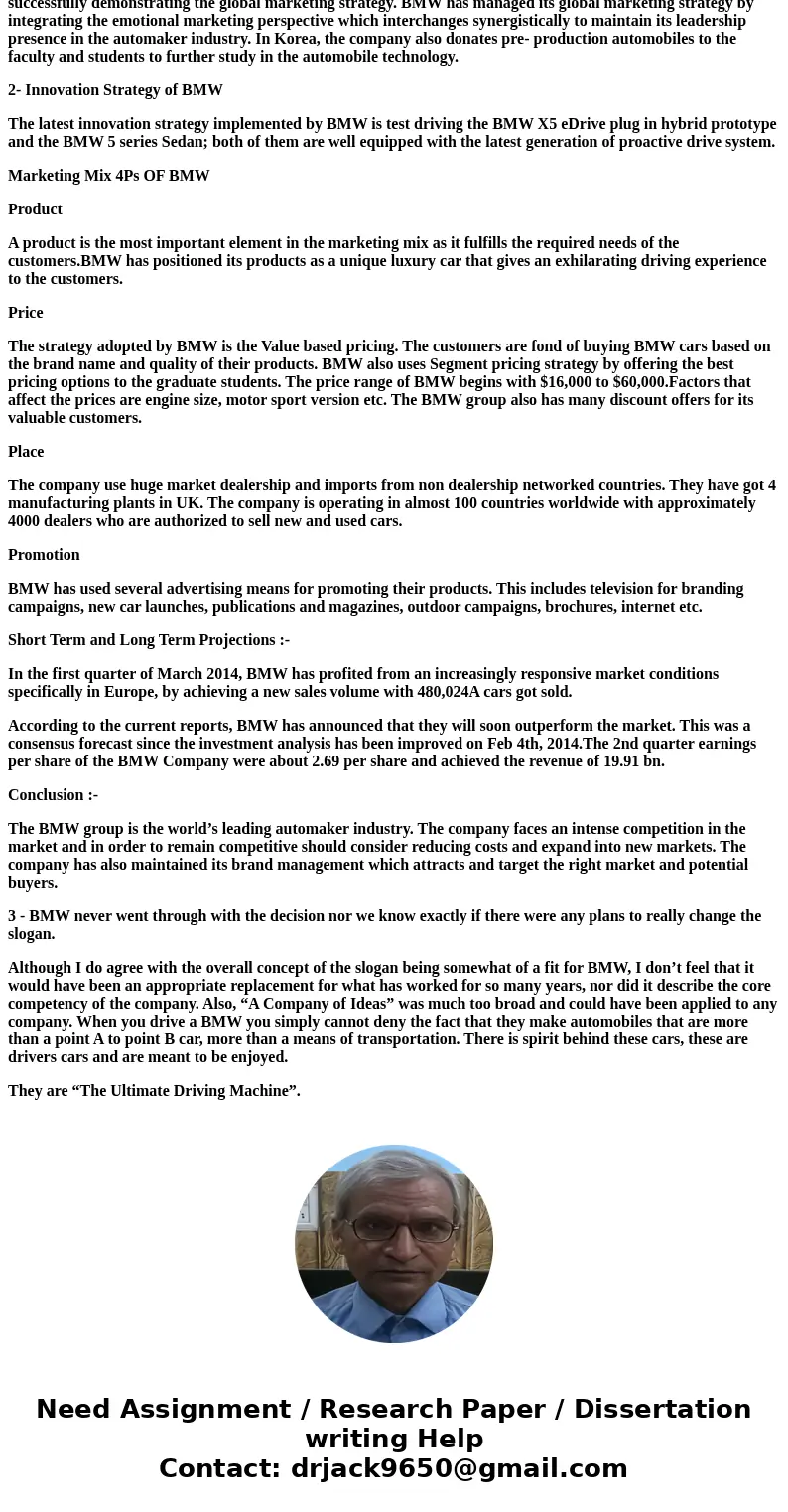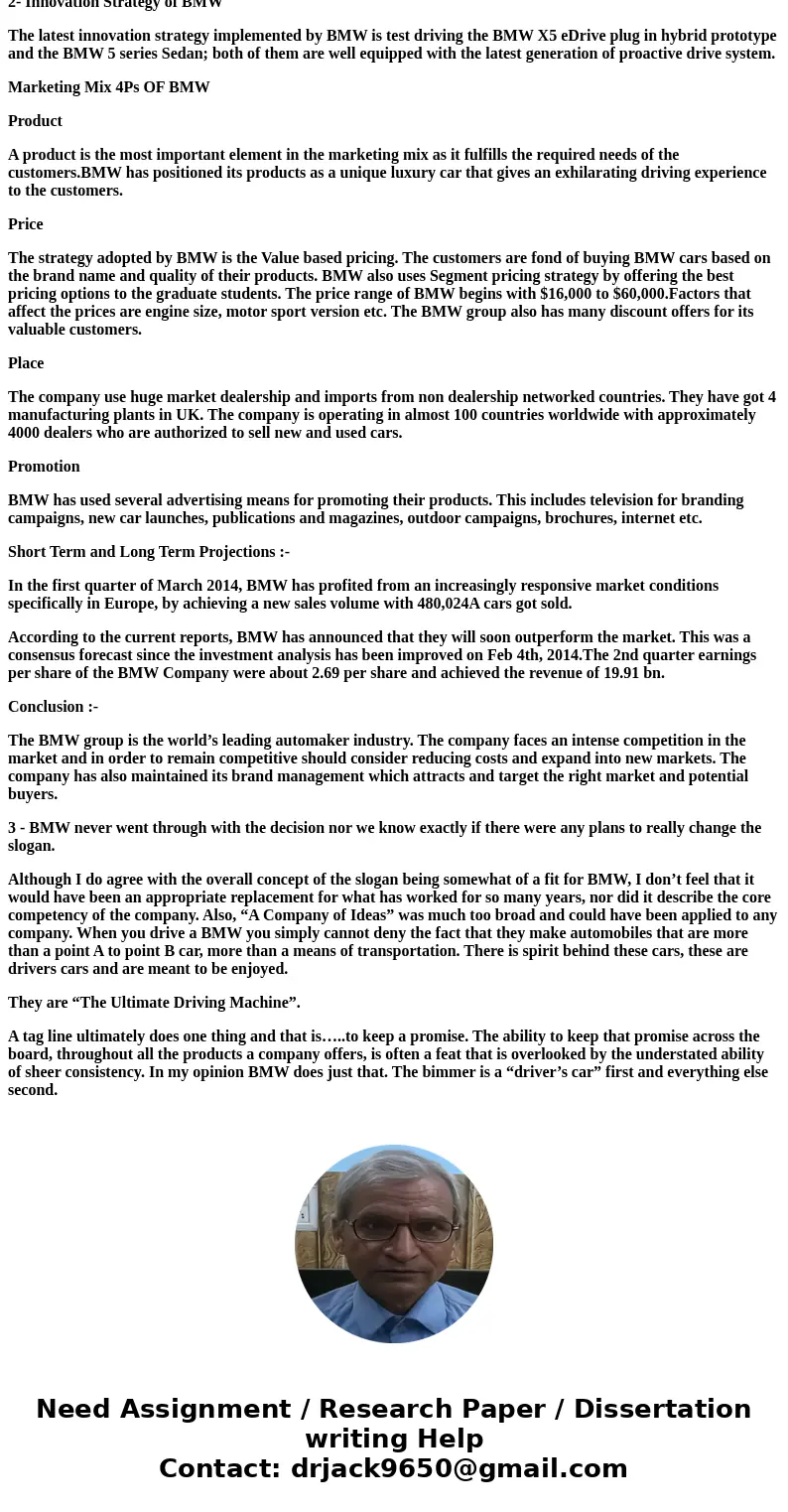BMW is the ultimate driving machine Manufactured by the Germ
BMW is the ultimate driving machine. Manufactured by the German company, BayerischeMotorenWerke AG, BMW stands for both performance and luxury. The company was founded in 1916 as an aircraft-engine manufacturer and produced engines during World War I and World War II. It evolved into a motorcycle and automobile maker by the mid-20th century, and today it is an internationally respected company and brand with €53 billion (about $76 billion) in revenues in 2008. BMW’s logo is one of the most distinct and globally recognized ever created. The signature BMW roundel looks like a spinning propeller blade set against a blue sky background – originally thought to be a tribute to the company’s founding days as an aircraft engine manufacturer. Recently, however, a New York Times reporter revealed that the logo, which features the letters BMW at the top of the outer ring and a blue-and-white checkered design in the inner ring, was trademarked in 1917 and meant to show the colors of the Free State of Bavaria, where the company is headquartered. BMW’s growth exploded in the 1980s and 1990s, when it successfully targeted the growing market of baby boomers and professional yuppies who put work first and wanted a car that spoke of their success. The result: sporty sedans with exceptional performance and a brand that stood for prestige and achievement. The cars, which came in a 3, 5, or 7 Series, were basically the same design in three different sizes. The 1980s was also a time when yuppies made Beemer and Bimmer, slang terms for BMW’s cars and motorcycles, popular names that are still used today. At the turn of the century, consumers’ attitudes toward cars changed. Research showed that they cared less about the bragging rights of the BMW brand and instead desired a variety of design, size, price, and style choices. As a result, the company took several steps to grow its product line by targeting specific market segments, which resulted in unique premium-priced cars such as SUVs, convertibles, roadsters, and less expensive compact cars, the 1 Series. In addition, BMW redesigned its 3, 5, and 7 Series cars making them unique in appearance yet remaining exceptional in performance. BMW’s full range of cars now include the 1 Series, 3 Series, 5 Series, 6 Series, 7 Series, X3 SUV, X5 SUV, X6 SUV, Z4 (Roadster), and M. The redesign of the 7 Series, BMW’s most luxurious car targeted a group called “upper conservatives”. These wealthy, traditional consumers traditionally don’t like sportier cars, so BMW added an influx of electronic components such as multiple options to control the windows, seats, airflow, and lights, a push-button ignition, and night vision, all controlled by a point-and-click system called iDrive. These enhancements were created to add comfort and luxury and attract consumers away from competitors like Jaguar and Mercedes. BMW successfully launched the X5 by targeting “upper liberals” who achieved success in the 1990s and had gone on to have children and take up extracurricular activities such as biking, golf, and skiing. These consumers needed a bigger car for their active lifestyles and growing families, so BMW created a high-performance luxury SUV. BMW refers to its SUVs as sport utility vehicles in order to appeal even more to these active consumers. BMW created the lower-priced 1 Series and X3 SUV to target the “modern mainstream”, a group who are also family-focused and active but had previously avoided BMWs because of the premium cost. The 1 Series reached this group with its lower price point, sporty design, and aspiration to own a luxury brand. The X3 also hit home with its smaller, less expensive SUV design. BMW introduced convertibles and roadsters to target “post-moderns”, a high-income group that continues to attract attention with more showy, flamboyant cars. BMW’s 6 Series, a flashier version of the high-end 7 Series, also targeted this group. BMW uses a wide range of advertising tactics to reach each of its target markets but has kept the tagline “The Ultimate Driving Machine” for over 35 years. During that time, US sales of BMW vehicles have grown from 15,000 units in 1974 to approximately 250,000 in 2009. BMW owners are very loyal to the brand, and enthusiasts host an annual Bimmerfest each year to celebrate their cars. The company nurtures these loyal consumers and continues to research, innovate, and reach out to specific segment groups year after year.
I need answers to these Questions:
1.How does BMW segment its consumers? Why does this work for BMW?
2. What does BMW do well to market to each segment group? Where could it improve its marketing strategy?
3. Should BMW ever change its tagline, \"The Ultimate Driving Machine\"? Why or why not?
Solution
Answer :-
1 - In 2010 BMW Group confirmed its position as the world\'s leading premium manufacturer in the automobile industry with record sales, and profits exceeding €3 billion. Since its inception, the BMW brand has stood for one thing: “sheer driving pleasure”. For many BMW drivers, owning a BMW has symbolic meaning of quality, efficiency and engineering expertise. BMW’s long-standing marketing message has been simply “the ultimate driving machine”, which is now 40 years old.
The company understands the logic of marketing the product globally and serving the customers based on their needs. BMW choose to sell to those consumers who have high standards for quality and luxury as their products are built on these attributes. The company focuses on the premium segments on a global scale. Producing attractive and trend setting products which ranges from 3 to 7 series are targeted to affluent customers by successfully demonstrating the global marketing strategy. BMW has managed its global marketing strategy by integrating the emotional marketing perspective which interchanges synergistically to maintain its leadership presence in the automaker industry. In Korea, the company also donates pre- production automobiles to the faculty and students to further study in the automobile technology.
2- Innovation Strategy of BMW
The latest innovation strategy implemented by BMW is test driving the BMW X5 eDrive plug in hybrid prototype and the BMW 5 series Sedan; both of them are well equipped with the latest generation of proactive drive system.
Marketing Mix 4Ps OF BMW
Product
A product is the most important element in the marketing mix as it fulfills the required needs of the customers.BMW has positioned its products as a unique luxury car that gives an exhilarating driving experience to the customers.
Price
The strategy adopted by BMW is the Value based pricing. The customers are fond of buying BMW cars based on the brand name and quality of their products. BMW also uses Segment pricing strategy by offering the best pricing options to the graduate students. The price range of BMW begins with $16,000 to $60,000.Factors that affect the prices are engine size, motor sport version etc. The BMW group also has many discount offers for its valuable customers.
Place
The company use huge market dealership and imports from non dealership networked countries. They have got 4 manufacturing plants in UK. The company is operating in almost 100 countries worldwide with approximately 4000 dealers who are authorized to sell new and used cars.
Promotion
BMW has used several advertising means for promoting their products. This includes television for branding campaigns, new car launches, publications and magazines, outdoor campaigns, brochures, internet etc.
Short Term and Long Term Projections :-
In the first quarter of March 2014, BMW has profited from an increasingly responsive market conditions specifically in Europe, by achieving a new sales volume with 480,024A cars got sold.
According to the current reports, BMW has announced that they will soon outperform the market. This was a consensus forecast since the investment analysis has been improved on Feb 4th, 2014.The 2nd quarter earnings per share of the BMW Company were about 2.69 per share and achieved the revenue of 19.91 bn.
Conclusion :-
The BMW group is the world’s leading automaker industry. The company faces an intense competition in the market and in order to remain competitive should consider reducing costs and expand into new markets. The company has also maintained its brand management which attracts and target the right market and potential buyers.
3 - BMW never went through with the decision nor we know exactly if there were any plans to really change the slogan.
Although I do agree with the overall concept of the slogan being somewhat of a fit for BMW, I don’t feel that it would have been an appropriate replacement for what has worked for so many years, nor did it describe the core competency of the company. Also, “A Company of Ideas” was much too broad and could have been applied to any company. When you drive a BMW you simply cannot deny the fact that they make automobiles that are more than a point A to point B car, more than a means of transportation. There is spirit behind these cars, these are drivers cars and are meant to be enjoyed.
They are “The Ultimate Driving Machine”.
A tag line ultimately does one thing and that is…..to keep a promise. The ability to keep that promise across the board, throughout all the products a company offers, is often a feat that is overlooked by the understated ability of sheer consistency. In my opinion BMW does just that. The bimmer is a “driver’s car” first and everything else second.



 Homework Sourse
Homework Sourse